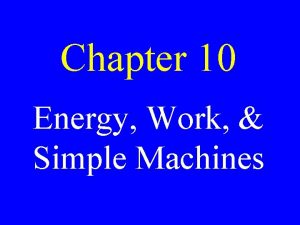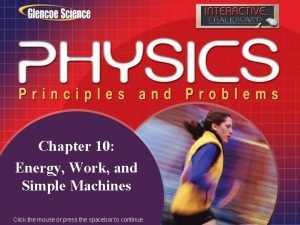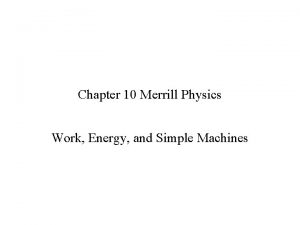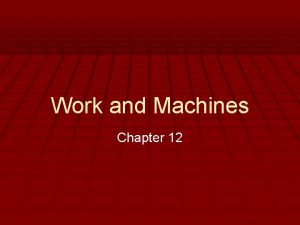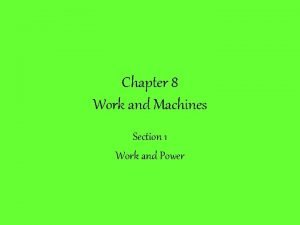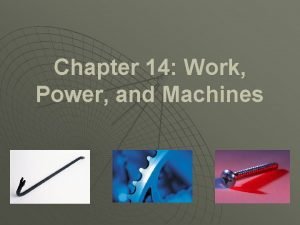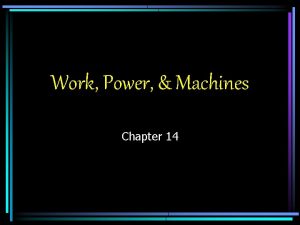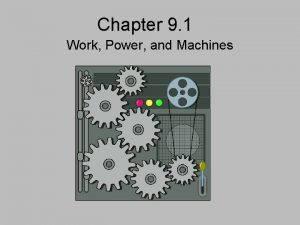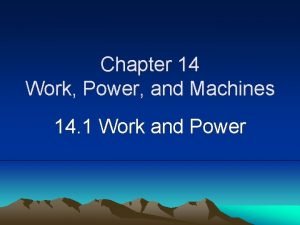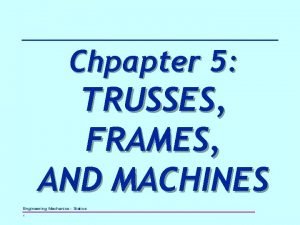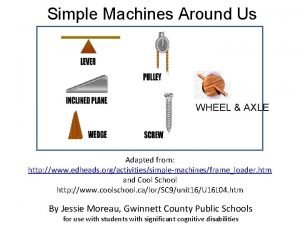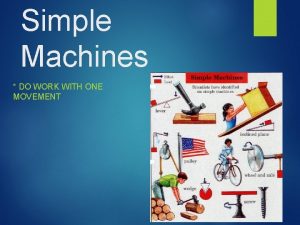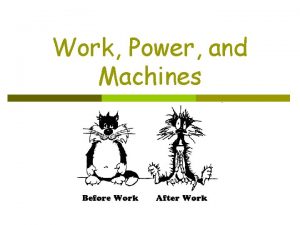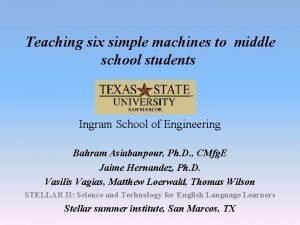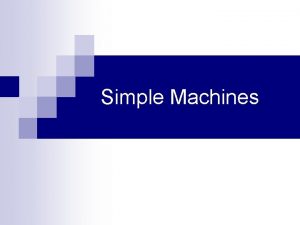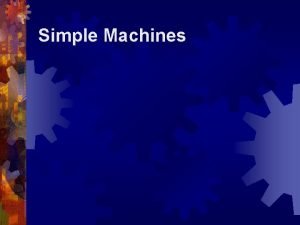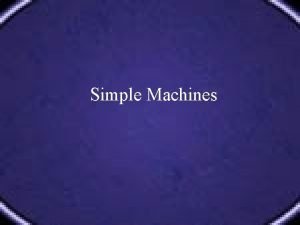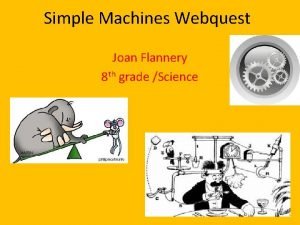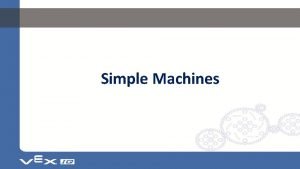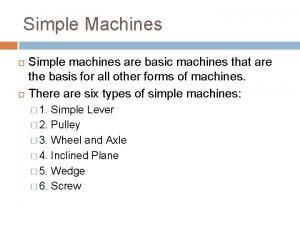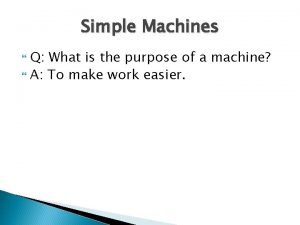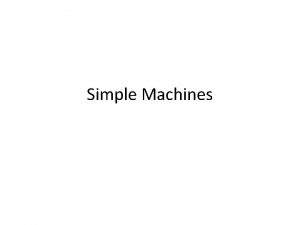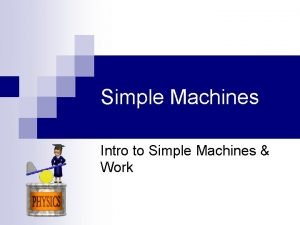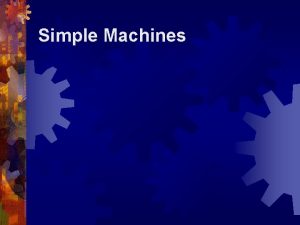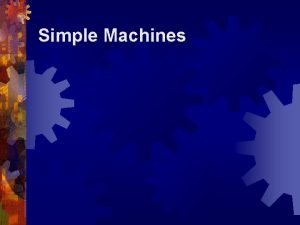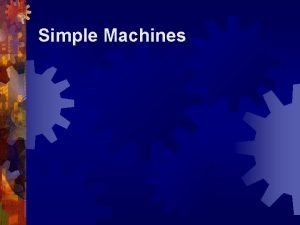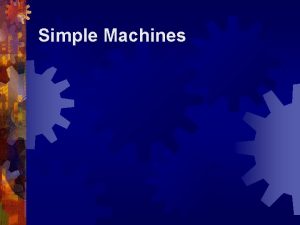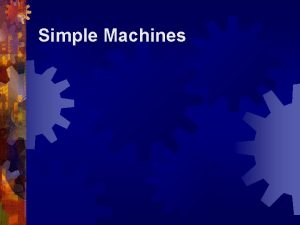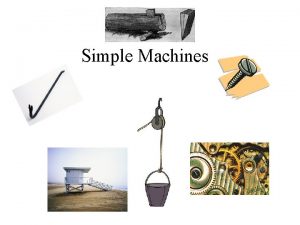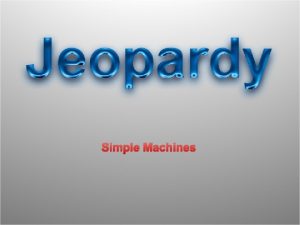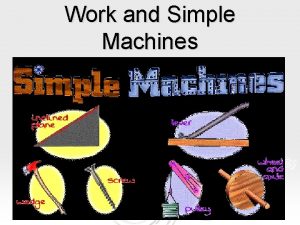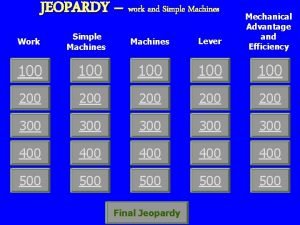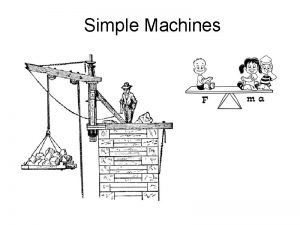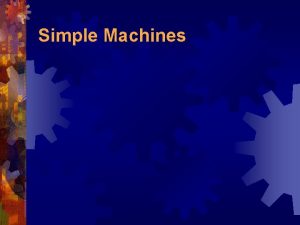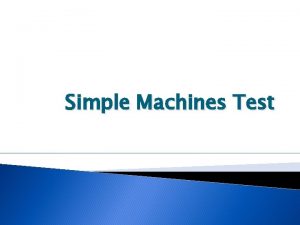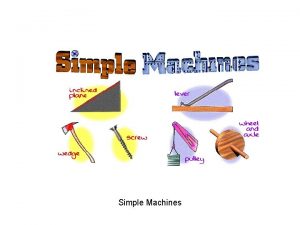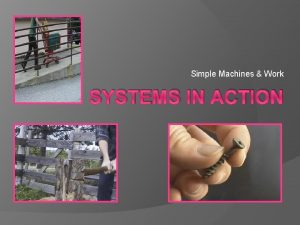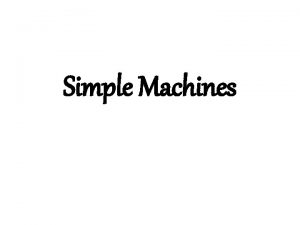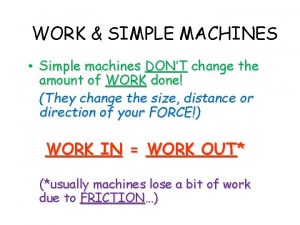Work and Simple Machines 1 What is work




































- Slides: 36

Work and Simple Machines 1

What is work? Ø In science, the word work has a different meaning than you may be familiar with. Ø The scientific definition of work is: using a force to move an object a distance (when both the force and the motion of the object are in the same direction. ) 2

Work or Not? Ø According to the scientific definition, what is work and what is not? l l a teacher lecturing to her class a mouse pushing a piece of cheese with its nose across the floor 3

Work or Not? Ø According to the scientific definition, what is work and what is not? l l a teacher lecturing to her class - NO a mouse pushing a piece of cheese with its nose across the floor - YES 4

The mouse is applying a force which produces motion in the same direction; therefore, the mouse is doing work 5

What’s work? Ø A scientist delivers a speech to an audience of his peers. No. (Does not involve force. Ø A body builder lifts 350 pounds above his head. Yes carries her baby from room to room. Ø A mother motion is sideways. ) Ø ANo. girl(Force pushesisa up cartand down a carpeted hallway. (Forcebelt andmoves displacement botha sideways. Ø AYes. conveyor people down long hallway? No 6

Formula for work Work = Force x Distance Ø The unit of force is newtons Ø The unit of distance is meters Ø The unit of work is newton-meters Ø One newton-meter is equal to one joule Ø So, the unit of work is a joule 7

W=FD Work = Force x Distance Calculate: If a man pushes a concrete block 10 meters with a force of 20 N, how much work has he done? 8

W=FD Work = Force x Distance Calculate: If a man pushes a concrete block 10 meters with a force of 20 N, how much work has he done? 200 joules (W = 20 N x 10 m) 9

Power Ø Power is the rate at which work is done. Ø Power = Work*/Time (Work =Force x distance) Ø The unit of power is the Joule per Second, which we call one Watt. 10

Check for Understanding 1. Two physics students, Ben and Bonnie, are in the weightlifting room. Bonnie lifts the 50 kg barbell over head (approximately. 60 m) 10 times in one minute. Ben lifts the 50 kg barbell the same distance over his head 10 times in 10 seconds. Which student does the most work? Which student delivers the most power? Explain your answers. 11

Ben and Bonnie do the same amount of work; they apply the same force to lift the same barbell the same distance above their heads. Yet, Ben is the most powerful since he does the same work in less time. Power and time are inversely proportional. 12

How much work will it take to move a 10 kg mass at an acceleration of 2 m/s 2 a distance of 8 meters? This problem requires you to use the formulas force and work, in the correct order. Force=Mass x Acceleration Work=Force x Distance 13

How much work will it take to move a 10 kg mass at an acceleration of 2 m/s 2 a distance of 8 meters in 5 seconds? Force=Mass x Acceleration Force=10 kg x 2 m/s 2 = 20 N Work=Force x Distance Work = 20 N x 8 m = 160 Joules (You could also calculate that Power = Work / time =160 J / 5 s = 32 J/s = 32 Watts) 14

History of Work Before engines and motors were invented, people had to do things like lifting or pushing heavy loads by hand. Using an animal could help, but what they really needed were some clever ways to either make work easier or faster. 15

Simple Machines Ancient people invented simple machines that would help them overcome resistive forces and allow them to do the desired work against those forces. 16

Simple Machines The six simple machines are: Ø l l l Lever Wheel and Axle Pulley Inclined Plane Wedge Screw 17

Simple Machines Ø A machine is a device that helps make work easier to perform by accomplishing one or more of the following functions: l l transferring a force from one place to another, changing the direction of a force, increasing the magnitude of a force increasing the distance and speed of a force 18

Mechanical Advantage Ø It is useful to think about a machine in terms of the input force (the force you apply) and the output force (force which is applied to the task). Ø When a machine takes a small input force and increases the magnitude of the output force, a mechanical advantage has been produced. 19

Mechanical Advantage Mechanical advantage is the ratio of output force divided by input force. If the output force is bigger than the input force, a machine has a mechanical advantage greater than one. Ø If a machine increases an input force of 10 pounds to an output force of 50 pounds, the machine has a mechanical advantage (MA) of 5. Ø In machines that increase distance, but reduce force, the MA is less than 1. Ø MA = output force/input force Ø 20

Mechanical Advantage Ø IDEALLY, a machine would give you as much work output as there was work input. This would lead to Fout x dout = Fin x din and when rearranged, In other words, you could calculate what the mechanical advantage should be just by measuring the input and output distances. 21

Machines don’t do work for you! They just change the way you do the work! No machine can increase both the magnitude and the distance of a force at the same time. 22

The Lever A lever is a rigid bar that rotates around a fixed point called the fulcrum. Ø The bar may be either straight or bent. Ø In use, a lever has both an effort (or applied) force and a load (resistance force). Ø 23

To find the MA of a lever, divide the output force by the input force, or divide the length of the resistance arm by the length of the effort arm. 24

Wheel and Axle The wheel and axle is a simple machine consisting of a large wheel rigidly secured to a smaller wheel or shaft, called an axle. Ø When either the wheel or axle turns, the other part also turns. One full revolution of either part causes one full revolution of the other part. Ø 25

Pulley Ø Ø Ø A pulley consists of a grooved wheel that turns freely in a frame called a block. A pulley can be used to simply change the direction of a force or to gain a mechanical advantage, depending on how the pulley is arranged. A pulley is said to be a fixed pulley if it does not rise or fall with the load being moved. A fixed pulley changes the direction of a force; however, it does not create a mechanical advantage. A moveable pulley rises and falls with the load that is being moved. A single moveable pulley creates a mechanical advantage; however, it does not change the direction of a force. The mechanical advantage of a moveable pulley is equal to the number of ropes that support the moveable pulley. 26

Ramp, or Inclined Plane Ø An inclined plane is an even sloping surface. The inclined plane makes it easier to move a weight from a lower to higher elevation. 27

Inclined Plane The mechanical advantage of an inclined plane is equal to the length of the slope divided by the height of the inclined plane. Ø While the inclined plane produces a mechanical advantage, it does so by increasing the distance through which the force must move. Ø 28

Although it takes less force for car A to get to the top of the ramp, all the cars do the same amount of work. A B C 29

Inclined Planes Ø Making an incline longer while keeping the height the same will increase the mechanical advantage, and reduce the needed effort force. Ø This same technique is used today in modern freeways which travel winding paths through steep mountain passes. 30

Wedge Ø The wedge is a modification of the inclined plane. Wedges are used as either separating or holding devices. Ø A wedge can either be composed of one or two inclined planes. A double wedge can be thought of as two inclined planes joined together with their sloping surfaces outward. 31

Screw Ø The screw is also a modified version of the inclined plane. While this may be somewhat difficult to visualize, it may help to think of the threads of the screw as a type of circular ramp (or inclined plane). 32

MA of an screw can be calculated by dividing the circumference by the pitch, the distance the screw moves in one turn. The finer the pitch, the more threads there are, and the greater the MA is. 33

Efficiency Ø We said that the input force times the distance equals the output force times distance, or: Input Force x Distance = Output Force x Distance However, in real life, some output force is lost due to friction. Ø The ratio of work output to work input is called efficiency. l l Ø Example: Put 200 J into a machine, but only get 180 J out. Efficiency = 180 J / 200 J = 0. 90 = 90% No real machine reaches 100 percent efficiency, due to friction. 34

Practice Questions 1. Explain who is doing more work and why: a bricklayer moving bricks across a parking lot in a wheelbarrow, or a worker who has to lift the bricks up one story to the top of a wall. The worker who lifts the bricks does more work. Upward force, upward motion. 2. a)How much work is done in pushing an object 7. 0 m across a floor with a force of 50 N and then pushing it back to its original position, assuming the same force is used? W=F • d = 50 N • 14 m = 700 Joules b) How much power is used if this work is done in 20 sec? Power = Work/Time = 700 J/20 s = 35 Watts 3. You can pull a rope with a force of 150 lb. Using a single fixed pulley, how heavy a load could you lift? What if you use a movable pulley with two strands? Fixed pulley doesn’t change force: you can only lift 150 lb. 2 -strand pulley: MA = 2, therefore output force = 300 lb. 35

Practice Questions 4. Give an example of a machine in which friction is both an advantage and a disadvantage. CAR! Need friction for tires to work, but friction reduces engine’s power. 5. Why is it not possible to have a machine with 100% efficiency? Some output force, and output work, is always lost to friction. 6. Two movers need to lift a 650 pound piano into a truck which has a floor which is 4 feet off the ground. They use a ramp which is 20 feet long. How much force will it take to push the piano up the ramp? M. A. = 20 ft/4 ft = 5. 0 650 lb / 5. 0 = 130 lb of pushing force 36
 Section 4 review physical science
Section 4 review physical science Chapter 10 energy work and simple machines answer key
Chapter 10 energy work and simple machines answer key Chapter 10 energy, work and simple machines answer key
Chapter 10 energy, work and simple machines answer key Energy work and simple machines chapter 10 answers
Energy work and simple machines chapter 10 answers Chapter 10 energy work and simple machines answer key
Chapter 10 energy work and simple machines answer key How does mechanical advantage work
How does mechanical advantage work Section 1 work and machines
Section 1 work and machines Chapter 14 work power and machines
Chapter 14 work power and machines Chapter 14 work power and machines
Chapter 14 work power and machines Chemical potential energy images
Chemical potential energy images Work power energy and machines
Work power energy and machines A crate of bananas weighing 3000 n
A crate of bananas weighing 3000 n Chapter 14 work power and machines
Chapter 14 work power and machines 6 machines simples
6 machines simples Truss in engineering mechanics
Truss in engineering mechanics Examples of wheel and axels
Examples of wheel and axels Ed heads simple machines
Ed heads simple machines Simple present simple future
Simple present simple future How do machines make work easier
How do machines make work easier Machine that does work with only one movement
Machine that does work with only one movement 6 types of simple machines examples
6 types of simple machines examples Slogan for simple machine
Slogan for simple machine Examples of wedge simple machines
Examples of wedge simple machines Sample of inclined plane
Sample of inclined plane An inclined plane wrapped around a center post
An inclined plane wrapped around a center post Bike compound machine
Bike compound machine What simple machines are in a lawn mower
What simple machines are in a lawn mower Simple machine webquest
Simple machine webquest Simple machines study guide
Simple machines study guide 6 simple tools
6 simple tools Picture of screw simple machine
Picture of screw simple machine Simple machine families
Simple machine families Simple machine
Simple machine Function of simple machine
Function of simple machine Identify the simple machine
Identify the simple machine Screw simple machine examples
Screw simple machine examples What are the six types of simple machines
What are the six types of simple machines


